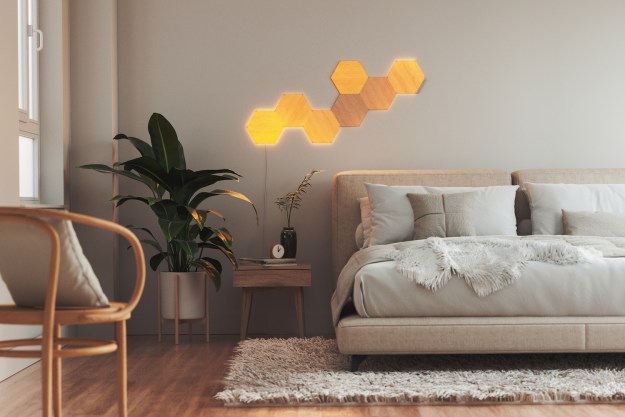
“You'll fall in love with the Nanoleaf Elements' rustic appearance, while appreciating their smart functions.”
- Unique lighting design unlike anything else on the market
- Easy to use, intuitive app
- Simple installation
- Incredibly customizable
- High price point
- No support for 5 Ghz networks
Nanoleaf smart lights have earned a spot in the background of more Twitch streams than I can count, and for good reason: The Nanoleaf Aurora and Nanoleaf Canvas look fantastic, with huge amounts of customization to fit nearly any mood. With that in mind, I jumped at the chance to review the Nanoleaf Elements, the newest entry in the company’s lineup.
Nanoleaf Elements look like they’re made out of wood and lit from within. Their purpose is ultimately decorative, but they stand out when placed on a wall and make for one heck of a conversation piece. This isn’t your ordinary set of smart lights!
Design: Natural light that makes you feel like you’re in a forest
The design of the Nanoleaf Elements is the main draw. The hexagonal design results in six specific points outfitted with an LED. This allows the Elements to produce light at each of the six points, lighting up from the outside in.
The faux-wooden panels draw the eye to them and give the lights a rustic appeal that make them a great addition to a dining room. While the Nanoleaf Elements only produce white light, the temperature of the light can be adjusted to create different levels of warmth. The light ranges from 1,500K to 4,000K — from cool white to warm white.

However, the light isn’t that bright. At only 22 lumens, you could use it for reading if you sat directly against it, but it won’t provide enough light for any sort of task-oriented work. It makes for great mood lighting, and with a 25,000-hour life span, these lights will last you a long time.
In my experience, the lights create a sort of peaceful atmosphere. They’re perfect for a quiet dinner or just to have on in the background while chatting with friends.
Simple installation
The Nanoleaf Elements are easy to install. It took less than 10 minutes to create the pattern I wanted on my wall, and that includes the 30 seconds of pressure required to apply each panel to the wall. The panels have a swiveling pad on the back on the back that allows you to adjust the angle with ease, and each side has an attachment for snapping the connectors into place.
Thanks to this design, you can create an almost infinite number of shapes and designs with tiles. A single power supply can support up to 22 panels, although the unit I reviewed came with only 10. The maximum number of tiles per controller is 80, but you would need to set up a truly impressive system to run up against the maximum number of tiles. It would take quite a bit of space — at 9 inches by 7.75 inches per title, the Elements are large enough to act as wall art all on their own.
A full set of features

Choosing the pattern and design of the tiles is up to you, and the Elements include a full set of features that give them a lot of different abilities.
For example, you can play music and sync the lights to pulse and shift in time with the beat. The Connect+ feature means the tiles automatically detect where each one is in relation to the other to ensure the lights shift in an organic, natural way. From within the Nanoleaf App, you can arrange tiles in specific patterns and assign roles to each one.
That leads into the next major feature that Nanoleaf offers: Touch controls. You can set specific tiles to perform tasks based on touch. For example, one panel can cycle through different HomeKit scenes, while another might change the pattern or turn the lights on in your home.
The Nanoleaf Elements also connect with all of the major smart home platforms and smart assistants. You can turn your lights on and off and change the pattern through Amazon Alexa, Google Assistant, and Apple HomeKit. The Elements also connect to Samsung SmartThings and IFTTT.
The Elements kit also comes with a manual control panel. All you have to do is connect it to one of your tiles to turn the panels on or off, change the pattern, shuffle the patterns, and more. I’d advise connecting it to the edge somewhere near the bottom, though. It doesn’t light up and sticks out like a sore thumb when the rest of the panels are lit.
An intuitive app
One of the standout features of the Nanoleaf Elements lies within how easy it is to use the aforementioned app. If you’ve used a Nanoleaf product before, then you know that there are thousands of user-created scenes for the Nanoleaf Aurora and Canvas. You might think you don’t have access to these scenes — after all, they rely on color — but that’s not totally correct.
The Elements translate all of the different colors into different levels of warmth. What this means is that every single scene is available for use. If you don’t like the default scenes and patterns in the app, just search for one that better suits your tastes.
The Layout Assistant allows you to visualize the design before you build it. Just arrange it and organize the tiles and then tap the eyeball icon at the bottom-right and it will show you what the pattern would look like on your wall using augmented reality.
You can also invite users through the app so that more people can control your lights.
Finally, you can use the Explore tab within the app to check out related apps, scenes, integrations, and much more. If you’re new to Nanoleaf, the Explore tab makes it easy to acquaint yourself with all of the different options the Elements bring to the table. You can also sign up to the Beta Program this way to explore new, not-yet-public features.

Our take
The Nanoleaf Elements are a gorgeous, fresh take on smart lighting that really set themselves apart with their rustic design. Other decorative smart lights seem targeted toward a game room or an arcade, but the Elements feel just at home in your mother’s kitchen as they do anywhere else. The ease of installation and the intuitive app are just cherries on top of a great core system.
Is there a better alternative?
There is no other smart lighting system quite like the Nanoleaf Elements on the market. Sure, there are plenty of lights that provide huge varieties of color, but if you want that natural look, the Elements are the only true option.
How long will it last?
With a life span of 25,000 hours, the Nanoleaf Elements will continue to operate for a long time. That’s 1,041 days and 16 hours, so unless you leave the lights running 24/7 (and even then, they’ll last for ages), your Elements will work for the foreseeable future. There is also a two-year warranty included with your purchase.
Should you buy it?
The Nanoleaf Elements are a fantastic lighting system, but the cost is a bit prohibitive. At $300 for the Elements Smarter Kit and $99 for each Expansion Pack, the Elements will leave a dent in your wallet. But if you want to create a unique lighting system in your home, there is nothing else like it.
Editors' Recommendations
- SimpliSafe is now using AI to prevent burglars from entering your home
- Yale’s newest smart lock is designed for renters
- Echo Hub vs. Echo Show 15: Which is the best smart home gadget?
- Echo Hub vs. Echo Show 8: Which is the best option for your smart home?
- The best smart light switch for Alexa, Google Home, and HomeKit








